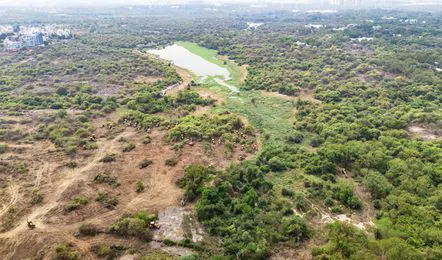
Hyderabad Central University Land Sale Triggers Protests, Legal Battle, and Emotional Outcry
MV RAMANA
The Telangana government’s decision to auction nearly 400 acres of land in Kancha Gachibowli, believed to be under the jurisdiction of the University of Hyderabad (HCU), has ignited a fierce backlash from the academic community, students, environmentalists, and political leaders. The land, long associated with the university, is now at the heart of a growing legal, moral, and political storm.
The Telangana State Industrial Infrastructure Corporation (TSIIC), acting on behalf of the government, has initiated the auction process, arguing that the land legally belongs to the state and is earmarked for IT development and infrastructure expansion. However, faculty members, alumni, and civil society groups have condemned the move, calling it a betrayal of public education, ecological responsibility, and the democratic values that underpin Telangana’s identity.
“This is not just about university land—it’s about the sanctity of public institutions and the very idea of education,” said Prof. Haragopal, a former faculty member at HCU. “Stanford has 8,000 acres, Harvard 5,000. A university isn’t just buildings—it’s an ecosystem where knowledge and nature coexist.”

A Legacy Rooted in Telangana’s Struggle
HCU was established in 1973 under the Six-Point Formula meant to address regional disparities in the erstwhile Andhra Pradesh. The university’s foundation is linked to the second point of this agreement, which was given constitutional backing through the 32nd Amendment. As such, any alteration to its land or institutional framework may require constitutional and legal review.
The university’s first Vice Chancellor, Prof. Gurbaksh Singh, initially sought 800 acres for the campus. Recognizing the need for a world-class institution, the government expanded the allotment to 2,200 acres. A compound wall was constructed with Rs. 1 crore in funding—marking an early effort to protect the land from encroachment. “Punjabis know the value of land—it must be protected,” Prof. Singh reportedly said, as recalled by then Registrar George.
Adding to its historical significance, the Golden Threshold—once the residence of Sarojini Naidu—was donated to the university, and a sapling planted by Mahatma Gandhi still grows there, underscoring the symbolic weight of the institution’s heritage.

Disputed Ownership and Ecological Concerns
The land now in question was once allotted to IMG Bharata in 2003 for a sports development project. After the project was scrapped, the state reclaimed the land. In a swap deal, the University was reportedly granted 397 acres in return—though formal registration was never executed.
UoH authorities and environmental experts argue that the land is not just part of the campus but a vital green zone, home to over 450 species of flora and fauna. “This area acts as an ecological buffer for the city. Its destruction would be irreversible,” said an environmental science researcher from the university.
Protests erupted last week as bulldozers arrived to begin clearing operations. Students formed human chains, leading to confrontations with the police, who detained several protestors. Public intellectuals and activists soon joined the demonstrations, framing the land auction as a symbolic struggle between commercial interests and educational values.

Legal Action and Political Fallout
Responding to public interest litigations filed by environmentalists and civic groups, the Telangana High Court issued interim orders staying further clearing or auctioning of the land. The case is expected to be a litmus test for the protection of public institutions in India’s rapidly urbanizing cities.
The issue has also turned into a political flashpoint. BRS working president K.T. Rama Rao accused the Congress-led government of “betraying the Telangana movement” and vowed that if his party returns to power, the land would be converted into a world-class ecological park.
During the Telangana agitation, KCR and Prof. Jayashankar had been felicitated on the HCU campus, where the university community requested them to protect the campus as part of Hyderabad’s legacy. KCR, at the time, assured them that the university’s land would be preserved—a promise upheld during his tenure.
Union Education Minister Dharmendra Pradhan also criticized the auction, urging the state to protect institutions of higher learning and their green campuses.
In contrast, the government argues that the auction is in the state’s economic interest. “This move will create jobs, boost IT development, and support Telangana’s growth trajectory,” said a senior TSIIC official, defending the decision.
A Reflection of Larger Concerns
Many former academics, including Prof. Haragopal, view this episode as part of a broader trend of commodifying public land. “Government land once symbolized the people’s property. Today, it’s seen as a real estate asset,” he said.
Past examples reinforce the contrast. In the late 1990s, when the Ministry of Education under H.N. Ananth Kumar and Minister Bommai requested land for the Urdu University, the then HCU Vice Chancellor Prof. Goverdhan Mehta argued for conserving the green zone. The minister respected the academic stance and withdrew the request—an act still remembered as a rare gesture of political sensitivity.
Now, the lack of registration is being used as justification to reclassify the land as “government property.” Legally sound or not, critics argue that morally and historically, the land belongs to the people—and to the generations of scholars educated there.
From producing IAS officers and cabinet ministers to researchers and writers, the University of Hyderabad has been a cradle of excellence. Selling its land, many argue, is not development—it is a disservice to future generations.
As the legal and political battle continues, the controversy surrounding the 400 acres of HCU land has emerged as a defining moment in the debate over education, environment, and governance in Telangana.



